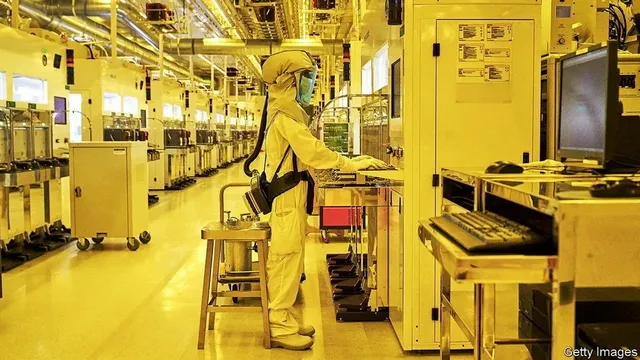According to Statista, there are 3.8 billion smartphone users in the world today, which leads us to that 48.33% of the global population possesses a smartphone. This is a significant increase from 2016, when there were just 2.5 billion users, accounting for 33.58% of the global population at the time.[1] And to power all these smartphones we need semiconductor “CHIPS”, which is a small but powerful word, we can call it “BRAIN” for many electronic devices.
We are all aware of the global pandemic scenario, as a result, people who were stranded at home began purchasing technology in greater numbers than ever before. They upgraded their computers and monitors to allow them to work from wherever. They purchased new laptops for their children to use for distance learning. They snatched up 4K televisions, game consoles, and a slew of other electrical gadgets to make life in quarantine a little easier. The pandemic transformed toward an expansive Black Friday.[2] But if you have a limited budget or you are not able to buy expensive electronics or gadgets, then you can manage all the work with the help of smartphones and people are doing more than before.
As a result of these factors, the worldwide smartphone market was valued at $714 billion in 2019 and is predicted to increase at a CAGR of 11.2 %. This market is dominated by Apple, Samsung, and Huawei. In Q4 2019, global smartphone shipments increased by 1% to 369 million devices, according to Canalys Senior Analyst Ben Staton. [3] Nowadays 5G is the focus of the smartphone industry. The global smartphone 5G market was valued at $13.4 billion in 2019, according to a Polaris Market Research Report, and is predicted to rise by 122.7 percent by 2027. Due to the epidemic, however, 5G expansion has slowed dramatically in 2020. [3]
From these, we can assure that the demand for smartphones and electronic devices increased during the COVID pandemic, The Consumer Tech Association, an American trade group, said that 2020 was the largest year on record with almost $ 442 billion in revenue. by retail sales, and projects high demand for devices, game consoles, headsets, and smart home products in 2021.[4]
As we can see, semiconductors are scarce due to the high demand for electronic products, changing business models in the semiconductor world which has created a bottleneck between outsourced chip factories. and the effects of the trade war between the United States and China. It all started under former President Trump. [5] According to Goldman Sachs, 169 US industries incorporate semiconductors into their products. The bank predicts an average 20% shortage of computer and smartphone chips among affected industries, with some of the components used to make chips in shortage until at least this fall and possibly until 2022.[6]
Global sales of devices are expected to fall 4.3% in 2020 and European sales by 7.4%, according to consulting firm Canalys. he predicted that global growth of 3.6% before the virus shut down much of the Chinese industry. [7] “There is a huge shortage of smartphone supply which we are already starting to see reaching some markets around the world,” said Ben Stanton, head of device research for Asia, Europe, the Middle East, and Africa at Canalys.[7] He said global cell phone production was 35% of normal levels in February will return to 85% this month and may return to normal in April. The collapse in production means it will take time to correct delivery delays for brands like Apple, Samsung, and Huawei. Canalys estimates are based on confidential comments from manufacturers, distributors, operators, and retailers.[7]
Experts say the 'new normal' in 2025 will be much more tech-driven, presenting greater challenges, and have been asked to reflect on what life will be like in 2025 following the onset of the global pandemic and 'other crises in 2020, about 915 innovators, developers, business and policy leaders, researchers and activists responded. Its broad and almost universal vision is that people's relationship with technology will deepen as larger segments of the population become more dependent on digital connections for work, education, healthcare, and business transactions. Daily and essential social interactions. A number describes it as a world of "tele-everything".[8]
Europe is home to the worst-affected countries, according to OECD forecasts, including the impact of a second wave of infections as lockdowns are slowly lifted. [9]
The whole world was stunned by this virus, but we have managed a way to survive like us, we don’t know if it’s the worst or biggest event among us, so we need a plan for every aspect of our lives. We want to get out of the crisis but first, we have to prepare mentally because it will take time and effort, we have to think about getting the situation back before 2019. Now every industry should have a plan for the impact of the crisis, be it an economic crisis, global warming, climate change, or anything more dangerous than Covid-19, we should be ready for anything. Otherwise, we have seen what the coronavirus did to the world, in my opinion, if we survive this global epidemic, it could be the biggest gain or the greatest reward in our entire lives.

Picture credit:
https://www.economist.com/finance-and-economics/2021/05/20/the-global-chip-shortage-is-here-for-some-time

#global-crisis #semiconductor-chips #short-semiconductorchips #smartphones #gadget-industry #smartphone-industry
Works Cited :
[1] https://www.bankmycell.com/blog/how-many-phones-are-in-the-world
[3] https://www.latentview.com/blog/how-covid-19-is-affecting-the-smartphone-industry/
[4] https://www.cnbc.com/2021/02/10/whats-causing-the-chip-shortage-affecting-ps5-cars-and-more.html
[5] https://www.cnbc.com/2021/02/10/whats-causing-the-chip-shortage-affecting-ps5-cars-and-more.html
[6] https://edition.cnn.com/2021/04/29/business/chip-shortages-smartphones-consumer-goods/index.html